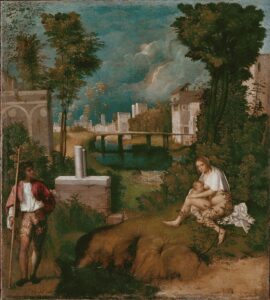Fourth Distinguished WAI Lecture on Renaissance Art and Culture
Wandering contemplation.
A new concept of the picture in the Venetian Renaissance, its medieval roots and some general considerations on the temporality of viewing
Prof. Dr. Johannes Grave, Department for Art History and Film Studies, Friedrich Schiller University Jena
Vice President (since 2024), Deutsche Forschungsgemeinschaft (DFG)/The German Research Foundation
Friday, 26 January 2024, 7.30-9.30 pm, UTC+8 Beijing, Shanghai, and Hong Kong, via Zoom
[11.30 am to 1.30 pm UTC+1, London; 12.30 to 2.30 pm, UTC+2, Berlin; 6.30 to 8.30 am, UTC-4, New York, Washington D.C.]

Giorgione, La Tempesta, c. 1508. Gallerie dell’Accademia, Venice
Around 1500, a “revolutionary novelty of pictorial language” (Salvatore Settis) can be observed in Venetian painting, which clearly deviates from the concept of “historia” as formulated by Leon Battista Alberti and implemented by early Renaissance painting, especially in Florence. Particularly in paintings by the old Giovanni Bellini, the early deceased Giorgione and the young Titian, there are hints of an alternative conception of what paintings can achieve. At the centre of this understanding is less an intellectual-scholarly ambition or the precise and reliable communication of certain thoughts than a form of perception in which viewing and contemplation are combined in a distinctive way. In addition to what a depiction gives us to see and reflect upon, i.e. the figures, actions and the meanings conveyed with them, what counts at least as much in Venetian pictorial culture is that a painting stimulates its audience to a specific doing and an unusual experience: to a thoughtful looking. The lecture will present this pictorial concept and ask to what extent it can be traced back to late medieval inspirations. The thesis will be put up for discussion that it is precisely the rather traditional cultural practice of Christian allegoresis from which essential impulses could be taken to arrive at a new conception of the possibilities of painting. This conception, in turn, was to become of great importance for the art of the early modern period. Pictures – as Venetian paintings show – cannot be reduced to being manifestations of a clearly predetermined meaning, but prove to be objects of open, temporally extending contemplation and reflection. Based on these observations, the concluding part of the lecture will outline more general considerations on the temporality of viewing pictures.
Registration
If you are residing outside mainland China and interested in attending this or other WAI lectures, please register for virtual participation: https://forms.gle/LAj5SkGCuy7Pgu1x9
